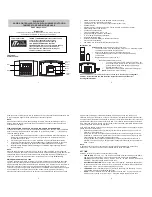
8 For your safety
VHF radios must be installed using an antenna
mounted centrally on the vehicle roof, with a gain of
2.15 dBi or 5.15 dBi.
UHF and 800 MHz radios must be installed using an
antenna mounted either centrally on the vehicle roof
with a gain of 2.15 dBi or 5.65 dBi, or centrally
mounted on the trunk with a gain of 5.65 dBi.
900 MHz radios must be installed using an antenna
mounted either centrally on the vehicle roof or
centrally mounted on the trunk with a gain of 2.15 dBi
or 8 dBi.
For radios with a transmit power of 25 W:
The radio must be installed using an externally
mounted antenna with a gain of either 2.15 dBi or
5.15 dBi.
This radio emits radio frequency (RF) energy or radio
waves primarily when calls are made. RF is a form of
electromagnetic energy (as is sunlight), and there are
recommended levels of maximum RF exposure.
To control your exposure to RF and comply with the
maximum exposure limits for occupational/controlled
environments, follow these guidelines:
■
Do not talk (transmit) on the radio more than the
rated transmit duty cycle. This is important
because the radio radiates more energy when it is
transmitting than when it is receiving.
■
While you are transmitting (talking or sending
data) on the radio, you must ensure that there is
always a distance of 35 inches (0.9 m) between
people and the antenna. This is the minimum
safe distance.
■
Use the radio only with Tait-approved antennas
and attachments, and make only authorized modi-
fications to the antenna otherwise you could dam-
age the radio and violate FCC regulations.
For more information on what RF energy is and how
to control your exposure to it, visit the FCC website at
www.fcc.gov/oet/rfsafety/rf-faqs.html
.
Summary of Contents for TM9315
Page 1: ...TM9315 DMR Mobile Radio User s Guide MMB 00016 06 Issue 6 December 2017 ...
Page 2: ......
Page 60: ...60 Directive 1999 5 CE Declaration of Conformity ...
Page 61: ......
Page 62: ......









































